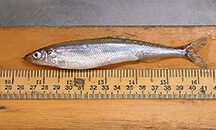Causes of Great Lakes smelt population decline are complex
February 24, 2015
 |
|
This smelt, at 6 inches, is about an inch longer than typical for the prey fish. (Purdue Department of Forestry and Natural Resources photo/James Roberts and Tomas Höök) |
WEST LAFAYETTE, Ind. - The reasons for the dwindling population of smelt prey fish in the Great Lakes to near historic lows are more complicated than previously believed, new research from Purdue University and collaborators suggests.
Although results of the 2014 study show that the number of smelt surviving their first few months actually has been rising since 2000, the increase in hatchlings isn't producing more adults. Whatever the cause, the loss of adult rainbow smelt is keeping the population on a downward trend even as offspring survival improves.
Perhaps the most surprising finding is that offspring survival is on the rise in Lake Michigan despite the fact that their parents are on average about 2 inches shorter now than what they were in the 1970s, dropping from about 6.5 inches in length to about 4.5.
"We were expecting to see a decrease in productivity because the adults are maturing at smaller sizes, which should mean fewer eggs and less healthy hatchlings," said lead author Zach Feiner, a Purdue doctoral student of Tomas Höök, associate professor of fisheries and aquatic sciences. "This raises a lot of questions about how well we understand rainbow smelt fisheries."
The researchers, including from the U.S. Geological Survey, Illinois-Indiana Sea Grant and the U.S. Environmental Protection Agency's Great Lakes National Program Office, discovered the unexpected increase in offspring after analyzing about 40 years of fisheries data using a novel modeling technique.
The researchers speculate that the drop in the number of adult smelt may actually be allowing hatchlings to thrive. Adult rainbow smelt frequently supplement their diet of zooplankton by eating their offspring. Fewer adults means fewer predators for juvenile smelt.
The need to find food in a lake infested with millions of quagga and zebra mussels that filter out plankton may be driving adults further out into the lake and away from spawning grounds, the researchers said.
Fish populations typically are analyzed using a statistical model that assumes the relationships among variables, such as number of offspring, number of adults, degree of predatory pressure and amount of rainfall, remain the same over time.
For this study, researchers used statistical tools rarely used by fishery scientists that better reflect the ever-changing nature of the Great Lakes and make it possible to detect more subtle population patterns.
Rainbow smelt are prey fish in each of the five Great Lakes, providing an important food for walleye, lake trout and stocked salmon species. Smelt also are predators to other species. The researchers said fluctuations in the abundance of rainbow smelt, therefore, can potentially influence multiple levels of Great Lakes food webs.
The research, published in the Journal of Great Lakes Research, was funded by the U.S. Geological Survey.
Writers: Anjanette Riley, Illinois-Indiana Sea Grant, 217-300-0407, aeriley@illinois.edu
Keith Robinson, 765-494-2722, robins89@purdue.edu
Source: Zach Feiner, 765-496-6799 (office of Tomas Höök), zfeiner@purdue.edu
ABSTRACT
Non-stationary recruitment dynamics of rainbow smelt: The influence
of environmental variables and variation in size structure
and length-at-maturation
Zachary S. Feiner 1; David B. Bunnell 2; Tomas O. Höök 1, 3;
Charles P. Madenjian 2; David M. Warner 2;
Paris D. Collingsworth 1, 3, 4
1 Department of Forestry and Natural Resources, Purdue University,
195 Marsteller St., West Lafayette, IN 47907, USA
2 U.S. Geological Survey, Great Lakes Science Center,
1451 Green Road, Ann Arbor, MI 48105, USA
3 Illinois-Indiana Sea Grant, Purdue University, 195 Marsteller St.,
West Lafayette, IN 47907, USA
4 U.S. Environmental Protection Agency,
Great Lakes National Program Office, 77 W. Jackson Blvd (G-17 J),
Chicago, IL 60604, USA
Fish stock-recruitment dynamics may be difficult to elucidate because of nonstationary relationships resulting from shifting environmental conditions and fluctuations in important vital rates such as individual growth or maturation. The Great Lakes have experienced environmental stressors that may have changed population demographics and stock-recruitment relationships while causing the declines of several prey fish species, including rainbow smelt (Osmerus mordax). We investigated changes in the size and maturation of rainbow smelt in Lake Michigan and Lake Huron and recruitment dynamics of the Lake Michigan stock over the past four decades. Mean lengths and length-at-maturation of rainbow smelt generally declined over time in both lakes. To evaluate recruitment, we used both a Ricker model and a Kalman filter-random walk (KF-RW) model which incorporated nonstationarity in stock productivity by allowing the productivity term to vary over time. The KF-RW model explained nearly four times more variation in recruitment than the Ricker model, indicating the productivity of the Lake Michigan stock has increased. By accounting for this nonstationarity, we were able identify significant variations in stock productivity, evaluate its importance to rainbow smelt recruitment, and speculate on potential environmental causes for the shift. Our results suggest that investigating mechanisms driving nonstationary shifts in stock-recruit relationships can provide valuable insights into temporal variation in fish population dynamics.
Ag Communications: (765) 494-2722;
Keith Robinson, robins89@purdue.edu
Agriculture News Page

